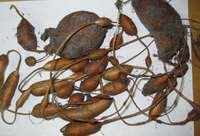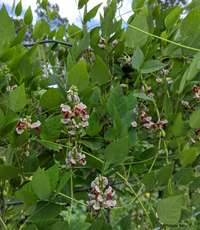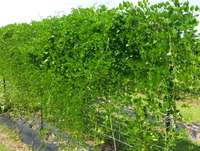Apios americana is a climbing, perennial vine and a member of the legume (Fabaceae) family. Common names for this crop include apios, ground nut, wild bean, bog potato, wild potato, Virginia potato, Indian potato, and wild bean. The plant, native to eastern parts of North America, was widely cultivated by Native Americans for its edible tubers and beans. It has grown well in the subtropical climate of ECHO’s Global Farm in southwest Florida (Sobetski, 2021). Its preference for trellis support makes it more difficult to grow on a field scale than a root crop like cassava (Manihot esculenta); however, A. americana is well-suited for small plantings around the home, producing protein-rich tubers that can be cooked in multiple ways.

Figure 8. Apios americana tubers. Source: Holly Sobetski
Uses
Many legumes are grown as green manure/cover crops, but A. americana is primarily cultivated for its starchy tubers that are an excellent source of carbohydrates and protein (Figure 8; Table 2). A. americana roots have more protein than other root crops shown in Table 2, and the protein in A. americana roots contains all the amino acids essential to human health (Neacsu et al., 2021).
| Nutritional category | Apios americanaZ | Cassava (Manihot esculenta)Y |
Potato(Solanum tuberosum)Y | Sweet Potato(Ipomoea batatas)Y |
|---|---|---|---|---|
| Protein | 13-17 | 3 | 9 | 5 |
| Carbohydrate | 47 | 87 | 67 | 78 |
| ZData from Kalberer et al. (2020) and Walter et al. (1986). | ||||
| YData from Chandrasekara and Kumar (2016). | ||||
2An antinutrient is a compound that interferes with the body's ability to absorb nutrients. A. americana has trypsin inhibitors, which keep the body from being able to digest protein.
A. americana tubers contain antinutritional factors 2 and should be cooked before eating. You can boil, fry, or steam the tubers, or cook them other ways that potatoes are typically prepared. The mature beans are also edible; these can be cooked like split peas. Note that some people have reported allergic reactions to consuming A. americana tubers and beans (Ecocrop, 2020).

Figure 9. Flowers and foliage of A. americana. Source: Holly Sobetski
The A. americana flowers attract butterflies and other pollinators (Figure 9). Additionally, the vines may be used for forage by grazing animals, although hairs on the vines limit their palatability (USDA, n.d.).
Growing conditions
A. americana thrives in well-drained soils that receive at least 700 mm rainfall annually (Ecocrop, 2020). It has a high tolerance for flooding and a moderate tolerance for shade (Stevens, 2006). Freezing temperatures will kill young plants, so in temperate areas tubers are typically planted after the last frost. A. americana can grow between sea level and 1000 m in altitude (Ecocrop, 2020). The plant is not salt tolerant and is most productive in moderate to very fertile soils.
Cultivation

Figure 10. A. americana plants grown on a wire trellis. Source: Holly Sobetski
Once the danger of frost has passed, or at the beginning of the rainy season, plant tubers 5 to 7.5 cm deep. If planting from seed, space seeds 30 cm apart and 2 cm deep in a single row with access to a trellis (Figure 10; Sobetski, 2021). For tuber production, vines can be cultivated with or without trellises. As plants grow, mulch the bases of the plants to retain soil moisture and reduce weed competition.
With tubers planted in April/May, our plants at ECHO's Global Farm in Florida flower in September/October and have full green pods by mid November (Sobetski, 2021). We harvest the roots when the plants die back in late December or early January. Tubers will be sweeter with cold weather. Tuber production has been shown to respond well to added fertility (Putnam et al., 1991). Harvest the tubers when the plants’ leaves begin to turn yellow and die back. Propagating plants from tubers will result in plants with traits identical to the parent plants. Plants grown from seed, on the other hand, will not have the exact same characteristics as the parent plants, due to the mixing of pollen--and, thus, genetic information--between plants. Planting A. americana from seed presents an opportunity to select for plants that grow and produce well under local conditions.
Seeds from ECHO
Active development workers who are members on ECHOcommunity.org may request a trial packet of seed. (See the website for how to register as a member and how to order seeds.)
References
Chandrasekara, A. and T.J. Kumar. 2016. Roots and tuber crops as functional foods: A review on phytochemical constituents and their potential health benefits. International Journal of Food Science 2016:1-15.
Ecocrop. 2020 (date accessed). Apios americana. Food and Agriculture Organization (FAO), Rome, Italy.
Kalberer, S., V. Belamkar, J. Singh, and S. Cannon. 2020. Apios americana: Natural history and ethnobotany. Legume Perspectives 19:29-32.
Neacsu, M., N.J. Vaughan, V. Perri, G.J. Duncan, R. Walker, M. Coleman, and W.R. Russell. 2021. Nutritional and chemical profiling of UK-grown potato bean (Apios americana Medik) reveal its potential for diet biodiversification and revalorization. Journal of Food Composition and Analysis 98:103821.
Putnam, D.H., G.H. Heichel, and L.A. Field. 1991. Response of Apios americana to nitrogen and inoculation. HortScience 26(7):853-855.
Sobetski, H. 2021. Personal communication.
Stevens, M. 2006. Groundnut, Apios americana Medik. Plant Guide. Accessed February 9th, 2021. https://plants.usda.gov/plantguide/pdf/cs_apam.pdf
USDA Natural Resources Conservation Services. n.d. “Conservation Plant Characteristics: Apios americana Medik.” Plants Database. Accessed February 9th, 2021. https://plants.usda.gov/java/charProfile?symbol=APAM
Walter, W.M., E.M. Croom, Jr., G.L. Catignani, and W.C. Thresher. 1986. Compositional study of Apios priceana tubers. Journal of Agricultural and Food Chemistry 34(1):39-41.
Cite this article as:
Boutell, M. 2021. Apios Americana. ECHO Development Notes no. 151.